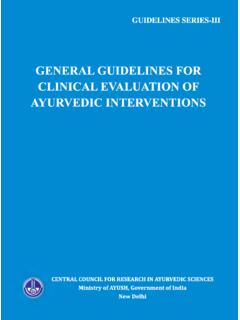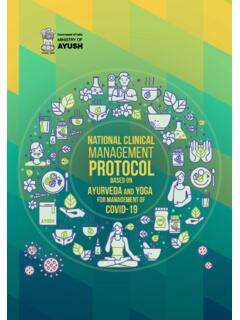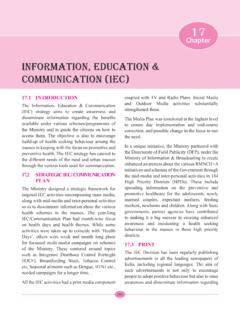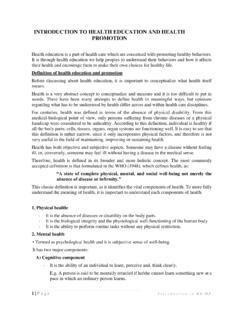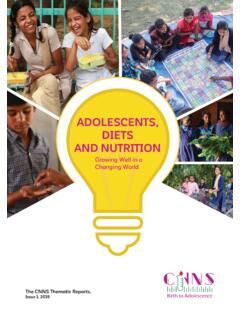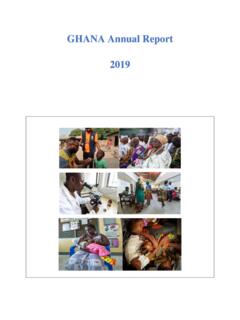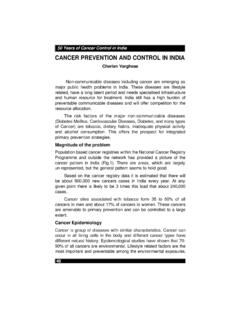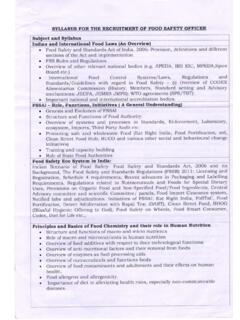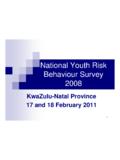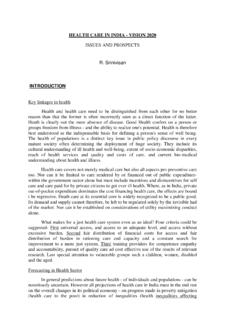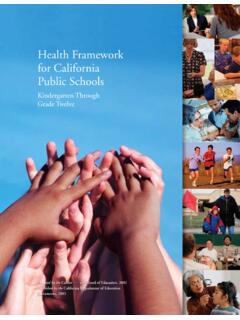Transcription of GUIDELINES
1 GUIDELINES . for YOGA. PRACTITIONERS. for COVID 19. GUIDELINES . for YOGA. PRACTITIONERS. for COVID 19. Design: Kamleshwar Singh 9810316649. Preamble Yoga is a discipline based on an extremely subtle science, which focuses on bringing harmony between mind and body. It is an art and science of healthy living. Yoga leads to a perfect harmony between mind and body, man and nature, individual consciousness and universal consciousness. Yoga helps to build up psycho-physiological health, emotional harmony; and manage daily stress and its consequences. Yoga is also useful in conditions where stress is believed to play a role(1). Various yogic practices such as Yogasanas, Pranayama, Dhyana (meditation), cleansing and relaxation practices etc. are known help modulate the physiological response to stressors. Several randomized controlled studies have shown the ef cacy of Yogic practices in management of non- communicable diseases like hypertension(2) , Chronic Obstructive Pulmonary disease (COPD)(3) , bronchial asthma(4) , diabetes(5) , sleep disorders(6), depression(7) , obesity(8), etc.
2 That can be comorbid conditions in patients with COVID 19. Yoga has also been shown to be useful in vulnerable population such as elderly, children. The function of the immune system is critical in the human response to infectious disease . A growing body of evidence identi es stress as a cofactor in infectious disease susceptibility and outcomes(9). Studies on yoga in managing u symptoms during an In uenza season have shown promising results. A recent randomized trial comparing meditation and exercise with wait-list control among adults aged 50 years and older found signi cant reductions in ARI. illness during cold season with mindfulness meditation(10) . Yoga is also known to increase mucosal immunity by increasing Salivary Beta Defensin-2 levels in elderly population(11). Considering that they are a vulnerable group to contract such infections, yoga may be useful as a preventive measure.
3 Yoga practices such as Kriya, Yogasana and Pranayama have been shown to reduce airway reactivity in elderly subjects with asthma and COPD(12) . Thus, suf cient evidence exists to justify testing the hypothesis that training in Yoga /Meditation can reduce susceptibility to ARI illness. Neti kriya is useful in acute coryza and symptoms of cold (13) . 1. Yoga may play signi cant role in the psycho-social care and rehabilitation of COVID-19 patients in quarantine and isolation. They are particularly useful in allaying their fears and anxiety. This document provides GUIDELINES for yoga professionals (Certi ed Yoga teachers/ instructors and therapists etc. ) to teach a safe set of Yoga practices based on available scienti c evidences, to novices in all walks of society as a service to humanity during this pandemic of COVID -19. This is complimentary to all measures that have been adopted.
4 Yoga based life style modules which can be used for different sections of the society in the present scenario are presented with the following objectives. 1. To improve general immunity among the population. 2. Prehabilitation of vulnerable populations (children, elderly and those with comorbid conditions such as diabetes and hypertension) and to those patients in isolation/quarantine with or without mild symptoms. 3. To add-on Yoga based interventions and Meditation practices in covid-19 cases in isolation and hospitalization for psycho- social care A Common Yoga Protocol (CYP) was developed by a team of leading Yoga Experts / Yoga Gurus that is being widely performed on International Day of Yoga (IDY) 21st June of every year. This protocol available on WHO m-app can be used by the general population to stay t along with other hygiene and social distancing measures in this current scenario.
5 2. Yoga based lifestyle modules for health promotion in healthy population;. Yoga Based life style module to improve immune resilience in healthy population of all age groups. CommonYoga Protocol (14). Forty-Five-minute module: The Common Yoga Protocol of IDY that was developed by a team of leading Yoga experts / Yoga Masters include safe practices to improve physical, mental, emotional and spiritual health of the population. Regular practice on empty stomach is recommended to improve immune resilience. Twenty and ten minute modules are recommended for children, adults, Youths and the elderly population to be repeated twice a day (morning and evening). Apart from CYP; Jalaneti, Sutraneti and Bhastrika Kriyas are recommended once or twice in a week and Yoga nidra for 20-30. minutes twice or thrice a week. Yogic Diet Follow the recommendations as per the medical advice on diet for your condition of diabetes, or heart disease etc.
6 And add-on these concepts from yoga that promotes mental health. This includes wholesome nutritious freshly cooked traditional home cooked food with plenty of fresh vegetables and fruits (with restrictions as per your disease condition) with added traditional spices in moderate quantities, consumed at regular timings. Abstinence from substance abuse including tobacco,alcohol and other addictive drugs To reduce disease susceptibility in high risk population This guideline recommends evidence based safe and simple yoga practices as mentioned above that promote heath of the respiratory, cardiovascular and the immune systems. 3. To add-on Yoga based life style to hospitalized cases without acute respiratory distress. As these subjects are hospitalized and they remain in bed without respiratory distress, the meditative practices without breath awareness practiced repeatedly is recommended.
7 Practice of deep relaxation of the body, slowing down of the breathing rate and calming down of the mind using any of the practices from any school of Yoga for twenty minutes repeated once every 3-4 hours during the day time using audio instructions is recommended. Some examples include: mindfulness meditation, transcendental meditation, yoga- nidra, progressive relaxation, quick relaxation, deep relaxation etc. 4. Yoga Practices for prevention, rehabilitation and to increase immunity. Yoga Practices Do's Dont's Bene ts 1. ShodhanaKriya Use lukewarm water for Should avoid in case of Neti helps in cleansing (Yogic cleansing cleansing. epistaxis, middle ear sinuses, bene cial in practices) Jalneti must be followed infection, and recent allergic conditions and Jalaneti, Sutra Neti, by kapalabhati to remove ENT surgery. reduces upper airway all water from nasal reactivity)(13,15).
8 Passage. Neti, is advised to practice weekly once or twice. 2. Yogic Move the joints as far as Do not over strain. Joint movements help to S k maVy y mas / possible. Avoid this practice in increase blood shithilikaranavyaya Do it slowly with breath case of severe joint pain circulation and reduce mas/ awareness and illness. stiffness which enhance Pawanamuktasana joint exibility. series (Joint Helps to facilitate asana movements): practices. Neck movements Shoulder rotation Trunk movement Knee movement Ankle rotation 3. Yogasana: Do it with breath Please avoid this Ushtrasana, awareness. practice in case of UtthanaMandukasana, Standing, Sitting, Cardiac patients shall do cardiac disorders, Tadasana, Trikonasana, Prone&Supine with care as advised by abdominal Vakrasana, lying Yoga experts . hernia,in ammation, Bhujangasana, Sarala Asanas that involve chest ulcers, recent abdominal Matsyasanaetc.
9 Practices expansion preferred surgery & vertigo. improves chest Hypertensive patients expansion and cardio- Simpli ed version/s shall should bend with care. pulmonary be followed be beginners Do not try to bend functions.(16). and elderly population beyond the limits and do not overdo the lateral stretch. 4. Kapalabhati 40-60 strokes per minute Hypertensive, cardiac Improves pulmonary problems, patients with functions and reduces respiratory secretions. distress,slipped disc Very useful preparatory patients should not do practice for pranayama it. practice Better to practice Helps to cleanse frontal it early in the morning sinuses. on an empty stomach 5. Yoga Practices Do's Dont's Bene ts 5. Breathing & Breath should be slow, In case of any cardiac Nadishodhan pranayama Pranayama: steady and controlled. disorders start with few reduces the sympathetic Sectional breathing It should not be forced or repetitions and activity and stimulate Nadishodhana restricted in anyway.
10 Gradually increase the vagal (para- Ujjayi Initially start the practice number of repetitions. sympathetic) activity Bhramari with few repetitions and Don't practice retention and decreases stress and gradually increase the or hold at initial stage. anxiety(17). number of repetitions. If possible, maintain the Ujjayi increase the ratio of 1:2 for inhalation oxygen saturation in and exhalation body(18). Bhramari pranayama similar to humming may increase Nasal Nitric Oxide (NO), which mayimprove blood ow to the ciliary epithelium and has anti- in ammatory action , - (19,20). 6 Yoga Nidra Follow mentally with Don't open the eyes until Reduction in (Pratyaahara) awareness as per the asked. sympathetic arousal and instructions given during Don't sleep reduced emotional practices. Don't ask any questions distress and improves Keep the eyes closed during the practice even quality of sleep.

